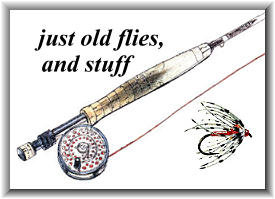Concerning this fly, the originator, Ken Cooper says:
"This fly just happened. Bass fishing and bass flies do not intrigue me very greatly, but
when I cannot fish for trout I do not scorn the bass or bluegill. They are an excuse to get
out in the open, which always seems to give me a new lease on life.
"In 1936, while preparing for a bass fishing, I put a hook in my fly-tying vise and tried
to figure out what to tie on it to try out on this trip. A red tail seemed to be a good
start so I put on a red deer hair tail, then a red wool body with a gold rib, next a bunch
of deer hair. I divided it to make wings at right angles to the hook. This gave me a
fly that would look reasonably large but be light in weight, also lift and handle nicely
with a bass rod. The butt of the deer hair blossomed out into quite a topknot but instead
of cutting it off, it was tied to stand upright and was cut flat across the top leaving a
V-shaped topknot about five-eighths of an inch high. The finished fly was tossed into
the air a few times to see how it would land and much to my surprise it always landed
right side up, the V top acting as a parachute.
"This was something different. I selected Pine Lake, a hard-fished body of water for
the try-out. It was a beautiful moonlight night and I fished alone and fished all night.
The bass seemed to like this bug and so did I, as the topknot gave it good visibility.
"I gave one of these bugs to Al Hilde, a brother-in-law of Paul Young, of Detroit, to try
out and asked him to suggest a name. He said it looked like a French poodle that had
been sheared, and suggested the name Poodle Bug and thus was it born and named.

"In 1938 Ray Bergman came out with a book called "Trout." While he was
gathering material for his book, Phil Armstrong thought he should have one of my flies
and I gave Phil a Poodle Bug, which he personally delivered to Ray. Phil thought he
could improve on the name of the fly so he told Ray the name was Cooper Bug.
On color plate number 15 in Bergman's book there is a picture of this fly and it
is called a Cooper Bug."
"It was Ken Cooper of Detroit who brought polar bear flies to the attention of fly
fishermen in the States. Ken, making no claim of being the originator says:
"I was working for Lou J. Eppinger in 1932 and used to prowl around in the
taxidermy shop, looking for fur or feathers to make flies. They had a mounted
polar bear that had outlived its usefulness. It was a sorry sight and I said to the
taxidermist, 'Why don't you throw it out?' and he said, 'I would like to, but the
boss thinks we should save it.' So I asked Lou how much he thought it was worth.
He smiled and said, 'Do you want it for fly tying material? Well, help yourself.'
I walked into the taxidermy shop and cut about a yard of hide off that bear, told
the taxidermist to wash it, cut it up in small pieces, put it in the tumbling barrel
with some hardwood sawdust and do a good job, and we would soon be rid
of that bear. I tied up some polar bear flies for the store and sold the balance
of the bear hide for fly tying. It did not last long."
Some folks just seem to have all the great ideas, although polar bear hair was
already popular in Canada, it had not been used in the US. The Cooper Bug
was a very successful trout fly as well.
~ LadyFisher
Credits: Quotes and drawing from Fly Pattern and Their Origins (1950),
by Harold Hinsdill Smedley, published by Westshore Publications,
Muskegon, Michigan. Colored photo from Ray Bergman's Trout.
|


